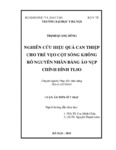
Please use this identifier to cite or link to this item:
http://dulieuso.hmu.edu.vn/handle/hmu/2080| Title: | Nghiên cứu hiệu quả can thiệp cho trẻ vẹo cột sống không rõ nguyên nhân bằng áo nẹp chỉnh hình TLSO |
| Authors: | Trịnh Quang, Dũng |
| Advisor: | PGS.TS. Cao Minh, Châu GS.TS. Nguyễn Thanh, Liêm |
| Keywords: | 62720166;Phục hồi chức năng |
| Abstract: | THÔNG TIN TÓM TẮT NHỮNG KẾT LUẬN MỚI. CỦA LUẬN ÁN TIẾN SỸ. Những kết luận mới của luận án:. Tỷ lệ trẻ vẹo cột sống có cột vùng cong riêng biệt ở ngực cao nhất, chiếm 44,4%, cong vẹo ở thắt lưng chiếm 31,7%, cong vẹo ở vùng ngực - thắt lưng chiếm 23,8%. Tỷ lệ trẻ có đường cong kết hợp là cao nhất, chiếm 76%.Tỷ lệ trẻ vẹo cột sống có hình dạng đường cong hình chữ C cao nhất.Tỷlệ trẻ bị vẹo cột sống có mức độ nặng chiếm 65,1% và rất nặng chiếm 34,9%. Các can thiệp được thực hiện tại bệnh viện và ở nhà đã làm giảm vẹo cột sống của trẻ tuổi 13-18 tuổi một cách rõ ràng thông qua số đo góc Cobb và số đo góc trung bình Scoliometersau 6 tháng và 12 tháng can thiệp. Số đo góc Cobb trung bình có xu hướng giảm rõ rệt sau can thiệp 6 tháng và 12 tháng có xu hướng giảm đáng kể, từ 44,5 độ (trước can thiệp) xuống còn 34,6 độ (sau 6 tháng) và giảm xuống chỉ còn 28,8 độ (sau 12 tháng can thiệp). Ở tất cả các đường cong: đường cong thắt lưng, đường cong ngực và đường cong thắt lưng-ngực, số đo góc Cobb trung bình có xu hướng giảm sau can thiệp 6 tháng và 12 tháng có xu hướng giảm đáng kể.Trên mô hình hồi qui đa biến các yếu tố như loại đường cong cột sống, mức độ vẹo trước can thiệp, luyện tập tại nhà của trẻ, kiến thức thái độ và thực hành của các bà mẹ ảnh hưởng đến mức độ tiến bộ cột sống sau can thiệp. Trẻ có độ cốt hóa càng ít có tiến bộ sau can thiệp cao hơn nhóm trẻ có độ cốt hóa nhiều. Trẻ có đường cong đơn tiến bộ sau can thiệp cao hơn nhóm trẻ có đường cong phối hợp. Trẻ có mức độ vẹo cột sống nặng tiến bộ sau can thiệp cao hơn nhóm trẻ có độ vẹo cột sống nhẹ. Trẻ có thực hành tập luyện tại nhà đạt yêu cầu tiến bộ sau can thiệp cao hơn nhóm trẻ không có thực hành tập luyện tại nhà đạt yêu cầu. Trẻ của những bà mẹ có kiến thức, thái độ và thực hành về PHCN đạt yêu cầu tiến bộ sau can thiệp cao hơn nhóm trẻ của các bà mẹ có kiến thức về PHCN chưa đạt yêu cầu. INFORMATION ON NEW FINDINGS OF THE THESIS. New findings: Percentage of scoliosis patients with single curve at thoraces was highest (44.4%), curve at lumbar area (31.7%), curve at thoracic-lumbar area (23.8%). The percentage of combined curve was 76%. The percentage of C curve was highest. Among those who had thoracic-area curve the percentage of the D7 apex was highest(53.6%). Among those who had lumbar area curve the percentage of L3 apex was 45%. Among those who had thoracic-lumbar area curve the percentage of D7 apex was 33.3%. Among those who had thoracic-lumbar area curve the percentage of L3 apex was 60%. Percentage of scoliosis with severe degree was 65.1% and more severe was 34.9%.. The intervention measures were carried out at hospital and home to reduce scoliosis of patients aged 13-18 significantly through Cobb andScolio-meter angles after 6 and 12 months of intervention. The average of Cobb angle was reduced obviously after 6 and 12 months of intervention from 44.5 (before intervention) to 34.6 (after 6 months of intervention),and reduced down to 28.8 (after 12 months of intervention). In all curves such as lumbar, thoraces and thoracic lumbar areas, the average Cobb reduced after 6 and 12 months of intervention.. In the logistic regression model, the factors as types of curves, levels of scoliosis, patient exercise practices, knowledge and practice of their parents influenced the progress of rehabilitation after intervention. Patients with low born-mature had more effect than the others. Patients with single curve had more effects than the others patients after intervention. Patient with severe curve had more effect than the. Patients with more exercise practices at their home had more improvements than the others.Patients with parents having good knowledge, attitude and practice in rehabilitation had more progress than the others.The study proposes there is a need to improve the knowledge of preventing the scoliosis for child parents and a need to have early rehabilitation intervention by using exercise practices, body traction as well as TLSO brace when low born maturing. It’s necessary to scale up the rehabilitation techniques, especially exercise practices, body traction as well as TLSO brace treatment to provincial hospitals to ensure more patients to have rehabilitation. It is also needed to follow up these patients to evaluate the long-term effects of the rehabilitation intervention.. |
| URI: | http://dulieuso.hmu.edu.vn//handle/hmu/2080 |
| Appears in Collections: | Luận án (nghiên cứu sinh) |
Files in This Item:
| File | Description | Size | Format | |
|---|---|---|---|---|
| 140_LA- PHCN.pdf Restricted Access | 4.9 MB | Adobe PDF |  Sign in to read | |
| 140_24- PHCN.pdf Restricted Access | 558.18 kB | Adobe PDF |  Sign in to read |
Items in DSpace are protected by copyright, with all rights reserved, unless otherwise indicated.